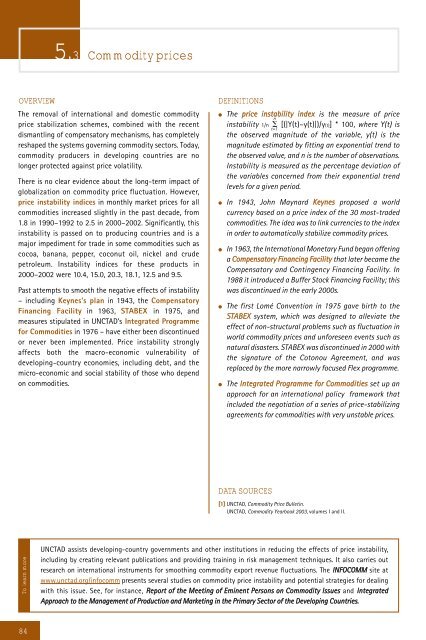Development and Globalization: - Unctad
Development and Globalization: - Unctad
Development and Globalization: - Unctad
Create successful ePaper yourself
Turn your PDF publications into a flip-book with our unique Google optimized e-Paper software.
OVERVIEW DEFINITIONS<br />
The removal of international <strong>and</strong> domestic commodity<br />
price stabilization schemes, combined with the recent<br />
dismantling of compensatory mechanisms, has completely<br />
reshaped the systems governing commodity sectors. Today,<br />
commodity producers in developing countries are no<br />
longer protected against price volatility.<br />
There is no clear evidence about the long-term impact of<br />
globalization on commodity price fluctuation. However,<br />
price instability indices in monthly market prices for all<br />
commodities increased slightly in the past decade, from<br />
1.8 in 1990–1992 to 2.5 in 2000–2002. Significantly, this<br />
instability is passed on to producing countries <strong>and</strong> is a<br />
major impediment for trade in some commodities such as<br />
cocoa, banana, pepper, coconut oil, nickel <strong>and</strong> crude<br />
petroleum. Instability indices for these products in<br />
2000–2002 were 10.4, 15.0, 20.3, 18.1, 12.5 <strong>and</strong> 9.5.<br />
Past attempts to smooth the negative effects of instability<br />
– including Keynes’s plan in 1943, the Compensatory<br />
Financing Facility in 1963, STABEX in 1975, <strong>and</strong><br />
measures stipulated in UNCTAD’s Integrated Programme<br />
for Commodities in 1976 – have either been discontinued<br />
or never been implemented. Price instability strongly<br />
affects both the macro-economic vulnerability of<br />
developing-country economies, including debt, <strong>and</strong> the<br />
micro-economic <strong>and</strong> social stability of those who depend<br />
on commodities.<br />
To learn more<br />
84<br />
5.3 Commodity prices<br />
● The price instability index is the measure of price<br />
n<br />
instability 1/n � [(|Y(t)–y(t)|)/y(t)] * 100, where Y(t) is<br />
t=1<br />
the observed magnitude of the variable, y(t) is the<br />
magnitude estimated by fitting an exponential trend to<br />
the observed value, <strong>and</strong> n is the number of observations.<br />
Instability is measured as the percentage deviation of<br />
the variables concerned from their exponential trend<br />
levels for a given period.<br />
● In 1943, John Maynard Keynes proposed a world<br />
currency based on a price index of the 30 most-traded<br />
commodities. The idea was to link currencies to the index<br />
in order to automatically stabilize commodity prices.<br />
● In 1963, the International Monetary Fund began offering<br />
a Compensatory Financing Facility that later became the<br />
Compensatory <strong>and</strong> Contingency Financing Facility. In<br />
1988 it introduced a Buffer Stock Financing Facility; this<br />
was discontinued in the early 2000s.<br />
● The first Lomé Convention in 1975 gave birth to the<br />
STABEX system, which was designed to alleviate the<br />
effect of non-structural problems such as fluctuation in<br />
world commodity prices <strong>and</strong> unforeseen events such as<br />
natural disasters. STABEX was discontinued in 2000 with<br />
the signature of the Cotonou Agreement, <strong>and</strong> was<br />
replaced by the more narrowly focused Flex programme.<br />
● The Integrated Programme for Commodities set up an<br />
approach for an international policy framework that<br />
included the negotiation of a series of price-stabilizing<br />
agreements for commodities with very unstable prices.<br />
DATA SOURCES<br />
[1] UNCTAD, Commodity Price Bulletin.<br />
[1] UNCTAD, Commodity Yearbook 2003, volumes I <strong>and</strong> II. Paper No. 159.<br />
UNCTAD assists developing-country governments <strong>and</strong> other institutions in reducing the effects of price instability,<br />
including by creating relevant publications <strong>and</strong> providing training in risk management techniques. It also carries out<br />
research on international instruments for smoothing commodity export revenue fluctuations. The INFOCOMM site at<br />
www.unctad.org/infocomm presents several studies on commodity price instability <strong>and</strong> potential strategies for dealing<br />
with this issue. See, for instance, Report of the Meeting of Eminent Persons on Commodity Issues <strong>and</strong> Integrated<br />
Approach to the Management of Production <strong>and</strong> Marketing in the Primary Sector of the Developing Countries.

















